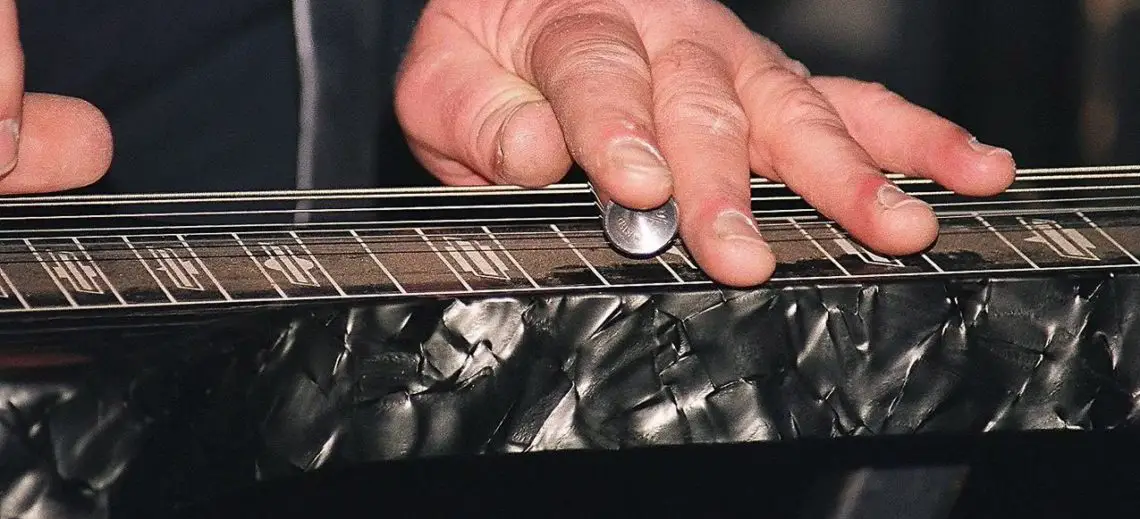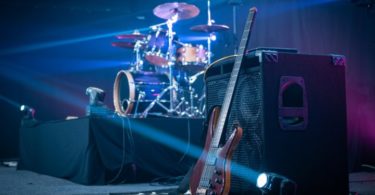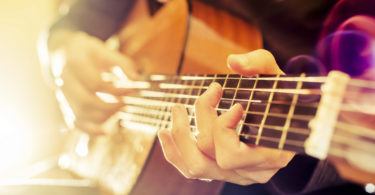When Ben Harper or David Lindley plays slide, they inevitably choose to use a lap steel guitar. That throaty, moaning wail of notes from records like Harper’s Burn to Shine has a different slide sound bottleneck style. Musicians play lap steel guitars with the strings facing upwards. With the strings raised, you hold a steel bar in one hand to stop the strings, forming notes and chords. The other hand plucks the notes.
With poplar wood construction, a conventional headstock for tuners, and two octave neck markers, and pickups that give a throaty, high midrange tone, the Morrell Plus is versatile and affordable.
The picking hand may use the thumb and fingerpicks for increased volume and a brighter, more articulate attack. Although when you amplify your notes, your bare fingers can offer greater nuance, like Ben Harper prefers. The microtonal sliding between notes is similar to that in bottleneck slide guitar. In fact, Sonny Landreth, Derek Trucks, and Joe Walsh have popularized them. However, the tone from the heavy bar on lap steel guitars is closer to its more complex cousin, the pedal steel guitar.
The shorter scale, budget materials and simpler design of lap steel guitars give them a funky, old-school vibe. They fit a variety of music genres, including rock, blues, country, R & B and gospel. Lap steel guitars also work well for jazz, world beat, and Hawaiian. Lap steel guitars are perfect for ethnic music that operate on scales other than the 12-tone Western scale.
-
 Check on Amazon
Check on AmazonWith poplar wood construction, a conventional headstock for tuners, and two octave neck markers, and pickups that give a throaty, high midrange tone, the Morrell Plus is versatile and affordable.
-
 Check on Amazon Search Used
Check on Amazon Search UsedThe maple body, which is a harder tonewood, contributes a brighter sound, that balances the lower midrange power of the Armstrong humbuckers.
-
 Check on Amazon Search Used
Check on Amazon Search UsedExcellent product from a top boutique luthier famous for its excellent sound and electronics.
-
 Check on Amazon
Check on AmazonThe sound has a warmth and growl to it without losing the highs that sometimes occurs with humbucking pickups.
-
 Check on Amazon
Check on AmazonAn excellent instrument that harkens back to vintage instruments but without the maintenance problems.
-
-
 $379.99Check on Amazon
$379.99Check on AmazonBears the traditional hallmarks of classic Gretsch lap steel guitars.
06/29/2025 04:06 am GMT -
 $349.00Check on Amazon Search Used
$349.00Check on Amazon Search UsedSound that many rockers dipping their toe into the lap steel pool for the first time, will find to be familiar turf.
06/28/2025 08:08 pm GMT -
 Check on Amazon Search Used
Check on Amazon Search UsedHas a somewhat modern garage type of sound that is right at home with White Stripes or Black Keys tones.
-
 $799.99Check on Amazon Search Used
$799.99Check on Amazon Search UsedMicrotonal possibilities give a player one of the best means to emulate a human voice on a stringed instrument.
06/28/2025 10:09 pm GMT
A Quick History of Lap Steel Guitars
Lap steel guitars are old instruments dating back to the late 19th century. Joseph Kekuku, a seven-year-old living in Hawaii, found that sliding a railroad bolt across his guitar strings made a sound akin to the human voice. He experimented with a pocket knife and other materials before settling on the heavy rounded bar that is standard now.
Kekuku became an international star and popularized Hawaiian music at the start of the 20th century. He appeared on stages across America and in films in 1932 and posthumously in 1951. Lap steel guitars became popular with Country and Western music during the Depression era. These guitars became a fixture in the genre when musicians added levers and pedals to them. This was to raise or lower certain strings while both hands were occupied.
The pedal steel guitar is too heavy to play on your lap in spite of its similarities to the lap steel. The primary types of lap steel guitars are either acoustically hollow or solid electric. While you can play a regular guitar lap style, lap steel instruments are a single slab if electric or if acoustic.
They also have a squared neck in the form of a hollow block for resonance and strength to hold tuning. The raised nut and saddle elevating strings are an inch or so above the fingerboard. They usually have markers but no frets. Acoustic lap steels are usually either a resonator type of instrument, such as a Dobro or a Tri Cone. They can also be a Hawaiian type wooden instrument, like a Weissenborn.
Different manufactures of lap steel guitars lend themselves to different styles, and musicians have their preferences. Dobro geniuses such as Jerry Douglas of Alison Krauss and Union Station, Mike Auldridge or the late Bob Brozman and his metal bodied Nationals have recorded the range of tone and sounds with these instruments.
While preferred primarily for slide playing, metal-bodied Dobros have also found favor for their unique sound. Mark Knopfler of Dire Straits used his fingerpicked Dobro for the title track from his hit record, Brothers in Arms. Both Dobros and Nationals come with both round neck and square neck versions. But Nationals are exclusively for lap-style playing.
Many music critics have acclaimed Douglas for developing a signature lyrical quality to his playing. It even plaintively complements the angelic vocals of Alison Krauss. The Nationals tend to have a faster decay but a cutting tone. They suit blues and ragtime playing, where syncopation is key to the rhythm.
Resonators
Resonator instruments use one or three aluminum cones in place of a soundhole to amplify the sound acoustically. They are popular in blues and bluegrass music.
The Tri Cone is metal bodied and sports three small cones instead of a single large one. Ordinarily, it has a sweeter, more sustaining tone than a single-coned instrument. Hawaiian stars, such as Sol Hoopii and Blues legend Tampa Red were famous Tri Cone players.
Hawaiian Type Acoustic Guitars
They named the Weissenborn model after Herman Weissenborn. He built the most popular Hawaiian type acoustic guitar during the 1920s and 1930s Depression era. Their bodies run practically the entire length of their fingerboards. They often consist of Hawaiian Koa wood mainly. It is a highly-prized tonewood with a sound somewhere between mahogany and maple.
Koa wood is indigenous to the Hawaiian islands. Several manufacturers make current copies of the design today. Ben Harper almost single-handedly revived interest in Weissenborn instruments, which faded from popularity by the 1950s. Harper’s first exposure to Weissenborns was at his parent’s music store. Also, David Lindley, a mentor and longtime Harper family friend, used Weissenborns throughout his lengthy career as a studio session ace.
Electric Lap Steel Guitars
The commercial electric lap steel guitar predates the electric Spanish guitar by a few years. Rickenbacker presented the A22 Frying Pan lap steel guitar in 1932. They became famous for their 12 string electrics George Harrison of the Beatles and Roger McGuinn of the Byrds popularized in the 1960s.
Shaped somewhat like a toy banjo, they called it the Frying Pan because of its neck and round body. However, it was the prototype for an instrument that has changed little in nearly 85 years. Electric lap steel guitars have six strings, a pickup and tuner. They also have bridge and nut, as well as markers for the notes on a slab body. Current lap steels still adhere to that same design formula.
Some are available with eight strings or as double-necked models for switching between different tunings. Today, steel bars are usually either cylindrically round bullet bars or finger groove topped Stevens bars. The bullet bars are easier to slant at an angle for unusual chord voicings. However, the Stevens bar is easier to lift when jumping to different areas of the neck.
All About Amplification
Amplification for lap steels is an important factor as it is for any other electric guitars. Lap steel played cleanly exhibits a pristine string sound, such as the opening slide intro for the famous Looney Toons theme. With overdrive and a Univibe pedal or rotating speaker simulation phase pedal, a lap steel can deliver vocal-like sounds.
Linda Ronstadt, David Crosby and Graham Nash in the 1970s and 1980s are examples of the depth and nuance of tone available from these simple instruments. Others to experiment with lap steel include Pink Floyd’s David Gilmour, Joe Perry of Aerosmith, Freddie Roulette, Dan Auerbach of the Black Keys, and Nels Cline of Wilco.
Ben Harper is renowned for his electric lap steel playing with his original tunes. However, he covers everything from folk songs, reggae and even Led Zeppelin on his Asher electric lap steel guitar, using distortion, wah wah, and other effects.
Roots rock virtuoso Junior Brown approaches steel from a different perspective. He designed a custom instrument he called “Guit Steel.” It combines a regular Fender Telecaster type guitar with a lap steel that mounts on a stand. This way he can nimbly switch back and forth between the two instruments with amazing dexterity.
Lap Steel Guitar Recommendations
This overview is going to focus solely on lap steel instruments that are commercially available. Because they are a niche instrument in small demand, finding a retailer who stocks them consistently may not be easy. Even large chain stores in major cities, such as Sam Ash and Guitar Center, will often only have one or two models in the entire store. Keep reading to learn about electric lap steel guitars and acoustic Weissenborn types, which are the common models commercially available now.
Some of the manufacturer names may be famous for their conventional guitar models. However, their drastically simpler design makes lap steel guitars easier to outsource to foreign factories. Their ability to keep costs low allows some boutique U.S. manufacturers to stay in the game and carve out niche reputations for themselves.
Joe Morrell
Joe Morrell in Bristol, Tennessee has been involved in the musical instrument sales and distribution business since the 1960s. A former professional country musician, Morrell started designing lap steel guitars in the 1970s. He wanted to provide affordable, quality USA-made instruments to musicians across the nation. While he makes both six and eight-string models with various features, here are some of the more obtainable catalog listings:
Morrell Plus
With poplar wood construction and a Kent Armstrong SpitFire single coil pickup, volume and tone knobs, the 29.25” Plus model has a conventional headstock for tuners.
With poplar wood construction, a conventional headstock for tuners, and two octave neck markers, and pickups that give a throaty, high midrange tone, the Morrell Plus is versatile and affordable.
It also has two octave neck markers across a 20.5” scale. The Kent Armstrong pickups are popular for their cutting, throaty high midrange tone. They also offer a left-handed version.
Morrell Pro
With the Pro, Morrell ups the ante considerably. It sports a slotted headstock with vertical tuners for easier access similar to those on a pedal steel guitar. The pro has a slightly larger 31.75” length and a dual blade Kent Armstrong HR1R Hot Rails mini humbucking pickup. It comes with three octave neck markers across a 22.75” scale.
Joe Morrell Pro Series 8-String Maple Body Lap Steel Guitar - Cherry Sunburst Finish USAThey also mounted a stainless-steel bridge onto the maple body. The maple body, which is a harder tonewood, contributes a brighter sound that balances the lower midrange power of the Armstrong humbuckers. The softer and mellower poplar version of the Pro is available for a little less than the Pro version.
Asher

Credit: Amazon.com
Billy Asher is the top boutique luthier. Artist have used his lap steel guitars and standard guitar models like Ben Harper, Lindsey Buckingham, Jackson Browne, Marc Ford, Beck and the Zac Brown Band. His instruments are highly regarded and fetch anywhere from $1,500 to $5,000 each on a direct order basis.
Excellent product from a top boutique luthier famous for its excellent sound and electronics.
However, he does have one mass-produced import model, the Electro Hawaiian Junior Lap Steel. It is available at a more affordable $675 that allows players of more humble means to experience the Asher mojo. Although it is Asher’s entry level model, the Electro Hawaiian Junior consists of solid mahogany. It has two humbucking pickups, a selector switch, volume and tone. It also has an Asher Hipshot custom bridge and 22 fret lines across a 25” scale.
For protection, they include a gig bag. The longer scale length, comparable to a standard electric guitar, makes the transition for guitarists who play bottleneck slide easier when playing lap steel. This is because the intervals between notes are not as minute. As a result, maintaining proper intonation is easier.
Asher guitars are famous for their excellent sound and electronics. However, an upgrade kit is available at a separate charge to hot rod the Electro Hawaiian Junior to come closer to parity with its American cousins. The kit consists of a pair of Jason Lollar Imperial humbuckers, an orange drop capacitor and two USA CTS ports.
SX Lap 2 Ash

Credit: Amazon.com
SX, Hadean, Agile and Douglas are some of the brand names for imported instruments from Korea, China, and Taiwan. They distribute them in the U.S., with Rogue Music of New Jersey being a primary reseller. Although quality control can vary, the majority of these instruments are well made. Some are surprisingly better than models from well-known brands.
The sound has a warmth and growl to it without losing the highs that sometimes occurs with humbucking pickups.
The lap steel models offered by these factories are sold under the SX brand. The SX Lap 1 is a mahogany slab with a rosewood fingerboard. It comes with 36 fret lines and chrome tuners, too. It also has a bridge cover over a wraparound Les Paul Jr. type bridge. You’ll get adjustable saddles, three removable support legs for playing while standing, and a Stratocaster type single coil pickup.
It also comes with a padded gig bag. The SX Lap 2 is the more interesting model. It concists of American Swamp Ash like a 50’s Telecaster. It also has a maple fingerboard and equivalent specs as the SX Lap 1, except that it has a P-90 pickup. A single coil design with fatter magnets than those used by Fender, the P-90 was one of the original pickup models Gibson used in the 1950s.
It may have been on the original Les Paul, Les Paul Junior and Special, Epiphone Casino, Gibson L5, Byrdland, and many other models. The sound has a warmth and growl to it without losing the highs that sometimes occur with humbucking pickups. The P-90 pickup is great for making slide guitar sounds. Since the SX Lap 2 and Lap 1 cost around the same, the versatility of tone is well worth the purchase of the Lap 2 if you are choosing between them.
Rogue RLS-1
The Rogue RLS-1 is an entry level lap steel they make in China on a mass-produced OEM scale. Rogue is a house brand of Musician’s Friend. This lap steel guitar falls under several other brand names, such as Cozart. But they are the same models with a generic unspecified wood slab body. They come with three octaves of fret lines and a single coil Telecaster type angled pickup.
It has a six saddle bridge in a 21” scale package with a protective gig bag. Some models include removable legs, as well. The downside is an awkwardly placed output jack that requires an angled plug to avoid blocking your picking hand when playing. However, the Rogue RLS-1 is a fun instrument that delivers usable lap steel tones.
It also has a funky vibe comparable to playing an old Teisco or Zim Gar electric guitar. At a thrifty price, it can be a great addition to your sonic palette for the price of a dinner and a movie date.
Recording King RG-31
Recording King is a company that has taken its inspiration from classic American instrument designs. They made some tweaks to accommodate the current market for their Chinese-made instruments, which have garnered positive reviews. Catering to many musicians in the American genre, their banjos, resonator guitars, and acoustic guitars have become quite popular among professional and semi-pros alike.
An excellent instrument that harkens back to vintage instruments but without the maintenance problems.
Artists such as Justin Townes Earle, Rob McCoury, Mark Spencer of Son Volt and Thao & the Get Down Stay Down are a few Recording King players. The Recording King RG-31 is a well-designed lap steel that tips a hat to classic lap steels of the 1940s and 1950s with quality materials to maximize value. Sporting a solid mahogany slab body, the RG-31 has a pearloid fingerboard like the Supros and Electars of over a half century ago.
The two octave fingerboard markers, vintage-style button tuners and string through design, like a Telecaster, gives the RS-31 a different tone than other lap steel guitars. The capper is an alnico P-90 pickup, which delivers a singing voice that can purr and roar at will. The RG-31 is an excellent instrument that harkens back to vintage instruments without maintenance problems.
Peavey Power Slide Robert Randolph Signature

Credit: Peavey Electronics
Located in Meridian, Mississippi, Peavey is one of the world’s largest music and P.A. sound equipment companies. Next to Leo Fender, Hartley Peavey is probably the most innovative music gear person in history. Holder of hundreds of patents, Peavey’s amplifier, P.A. and instrument designs and CNC manufacturing processes pioneered many of the breakthroughs that have become standard in the industry.
Unusual shark fin on an axe profile is bound to attract attention
While Peavey’s motto has always been “great gear at a fair price,” many top artists, such as Lynyrd Skynyrd, Michael Anthony, Hank Williams Jr., and Rusty Cooley, choose Peavey for its quality and reliability regardless of price. They are also one of the first P.A. and amp companies to supply gear specifically for the House of Worship market. In fact, Peavey amps are a staple at many church and with worship leaders, especially in the gospel community.
Some of the breakout stars of the Sacred Steel tradition of church music using steel guitars rather than organs are the Campbell Brothers and Robert Randolph. Hailing from New Jersey, Robert Randolph became a fixture on the jam band scene, playing his custom Fessenden 13 string pedal steel to audiences more accustomed to Phish or the Dave Matthews Band. He won them over with his soulful vocals, churning boogie rhythms, and incredible virtuosity. He would reel off Hendrix licks and complex chord voicings with a nonchalant grin.
A Word on Peavey Solid State Amps
His long experience with Peavey solid state amps prompted Luther Dickinson to obtain an old Peavey Artist amp for their project, The Word. He wanted to nail the guitar sound he heard on so many of the gospel and R & B records that influenced his writing. Randolph’s first signature instrument is a collaboration with Peavey they based on their Powerslide model. The unusual shape is ergonomically designed to play either vertically or horizontally.
It has a slotted headstock with vertical tuners and a two-octave neck. It also has a variable coil humbucking pickup they based on the Peavey T-60 guitar model. Unique to the Randolph model are an extra single coil pickup at the end of the fingerboard, a belly rest, and upgraded hardware. And they’ve packaged it all in a specially designed gig bag.
Randolph uses his signature Powerslide in both the studio and onstage. The unusual shark fin on an axe profile is bound to attract attention.
Gretsch Electromatic

Credit: Sam Ash Quikship Corp
Another iconic guitar company, Gretsch is famous for its archtop electrics. They have been seen and heard both on record and onstage by players such as Chet Atkins and Neil Young. Other artist fans of Gretsch are Brian Setzer, Billy Duffy, Stephen Stills, Randy Bachman ad Pete Townshend.
Bears the traditional hallmarks of classic Gretsch lap steel guitars.
Fred Gretsch originally founded in the company in New York City. His heirs continue to manage the company Fender own the majority of now. The Electromatic Lap Steel bears the traditional hallmarks of classic Gretsch lap steel guitars. It has a plastic deco fingerboard with various triangle, square and diamond markers. It also comes with an asymmetrical mahogany slab body, a string through design, a single coil pickup and “G” arrow knobs.
As an import model, the current Gretsch Electromatic suffers somewhat from a solid but generic tone that may be unfairly compared to its vintage predecessors but it is a serviceable instrument.
Epiphone Electar

Credit: Epiphone
Epiphone is another guitar brand with an illustrious history. It was once a fierce rival of Gibson in the archtop guitar arena through both World Wars. However, Epiphone was a favorite brand of Les Paul, who urged founder Epi Stathopoulo to merge with Gibson in the late 1950s. Maintaining its independence, Epiphone continued to design and sell iconic instruments, including the Beatles favored Casino.
Sound that many rockers dipping their toe into the lap steel pool for the first time, will find to be familiar turf.
They also built the jazz favorite Emperor and Broadway, and its slope shouldered acoustic Texan. Epiphone also made a significant number of lap steel models in the post World War II era until the late 1960s. After neglecting lap steels for decades, Epiphone has revisited its heritage with the Epiphone Electar the 1939 Lap Steel model inspired. Taking elements of their classic models, the Electar has a mahogany slab body in the same profile as the Electars of the past.
The Plexiglas fingerboard has Art Deco designs circa 1939 across 28 frets and the classic Epiphone Badge headstock insignia. It has a vintage looking but modern spec three line tuners from Wilkinson, an aluminum nut and tailpiece, and a 500B bladed humbucking pickup with gig bag. The fatter humbucking pickup sound is a departure from the classic Electars. But it is a sound many rockers playing lap steel guitars for the first time will find to be familiar turf.
Eastwood Airline Lap Steel

Credit: Airline Guitars
Mike Robinson, President of Eastwood and Airline Guitars, created the company to recreate the forgotten vintage guitar models he missed but could not obtain due to attrition. They’ve managed to update these designs to appeal to modern players while capturing the mojo of the original classics. Eastwood has thrived with its reissue version of Mosrites Ventures guitars, non-reverse Gibson Firebirds, Ovation Deacons, and Valco models artists like Jack White, David Bowie and Bill Nelson favor.
Has a somewhat modern garage type of sound that is right at home with White Stripes or Black Keys tones.
The Airline Lap Steel is Eastwood’s tribute to the National, Supro and Valco lap steels Montgomery Ward offered in the 1960s. Shaped like a rocket with wings, it has a basswood body and a Hot Rail humbucking pickup. The Airline comes with a ceramic fingerboard, a six saddle Stratocaster style bridge and 36 frets.
Oozing with old school vibe, the Airline has a somewhat modern garage type sound right at home with White Stripes or Black Keys tones.
Gold Tone LM Weissenborn Acoustic Slide Guitar / LS-6

Credit: Gold Tone Music Group
Gold Tone is a company in Florida that specializes in acoustic instruments for the Americana market. Their reissues and innovations of classic banjos, ukeleles, resonators, mandolins and basses are well regarded. In fact, their six-string Banjitar is a bestseller. Gold Tone artists include banjo whiz Bela Fleck, Dan Weller of Florida Georgia Line, Roger McGuinn, Kaki King, Buddy Miller and Ben Harper.
Microtonal possibilities give a player one of the best means to emulate a human voice on a stringed instrument.
The Gold Tone LS-6 is great for beginners. Made with mahogany construction, the Gold Tone LS-6 is modeled after the Oahu Tonemaster, one of the most revered lap steels of the 1950s.
The Gold Tone LM Weissenborn is a re-creation of the classic Weissenborn style. It includes high gloss mahogany construction and a hollow square neck, rope binding. It also has an ebony bridge, 18 frets, traditional inlays and Kluson style tuners. Gold Tone is a stickler for tradition, and warns owners they designed and crafted their slide guitar to Herman Weissenborn’s original specifications.
Tune this guitar to open G (DGDGBD), open D (DADF#AD) or other tunings that don’t exceed 165 pounds at the A440 pitch. Playing a Gold Tone Weissenborn model is like playing a classic reissue of a Fender Jazzmaster or other semi-famous guitar. There are elements of updating subpar materials or parts like tuners, but they have taken care to be faithful to the vintage models as closely as possible.
Some Final Words on Lap Steel Guitars
Playing lap steel guitars require a different approach from playing bottleneck slide guitars. The weight of the steel, the height of the strings, and the physical mechanics of playing force you to rethink the instrument. You need to play within the limitations of using the bar by choosing different chord voicings or partials to imply accompaniment to melody. The microtonal possibilities give a player one of the best means to emulate a human voice on a stringed instrument.
To recap, here’s the final competition:
With poplar wood construction, a conventional headstock for tuners, and two octave neck markers, and pickups that give a throaty, high midrange tone, the Morrell Plus is versatile and affordable.
The maple body, which is a harder tonewood, contributes a brighter sound, that balances the lower midrange power of the Armstrong humbuckers.
Excellent product from a top boutique luthier famous for its excellent sound and electronics.
The sound has a warmth and growl to it without losing the highs that sometimes occurs with humbucking pickups.
An excellent instrument that harkens back to vintage instruments but without the maintenance problems.
Unusual shark fin on an axe profile is bound to attract attention
Bears the traditional hallmarks of classic Gretsch lap steel guitars.
Sound that many rockers dipping their toe into the lap steel pool for the first time, will find to be familiar turf.
Has a somewhat modern garage type of sound that is right at home with White Stripes or Black Keys tones.
Microtonal possibilities give a player one of the best means to emulate a human voice on a stringed instrument.














Interesting to see the Eastwood/Airlines in here. While they can be decent (for the price) ones priced on the low end can have some workmanship limits. Yes if you like that style they do look pretty cool, and sound ain’t bad on them all. I enjoyed the Wandre especially. Had some fun with that one and it wasn’t troublesome.
Terribly written article. Who fact checks this stuff. And if a Morrel is your #1 pic then you don’t know much about lap steel quality.